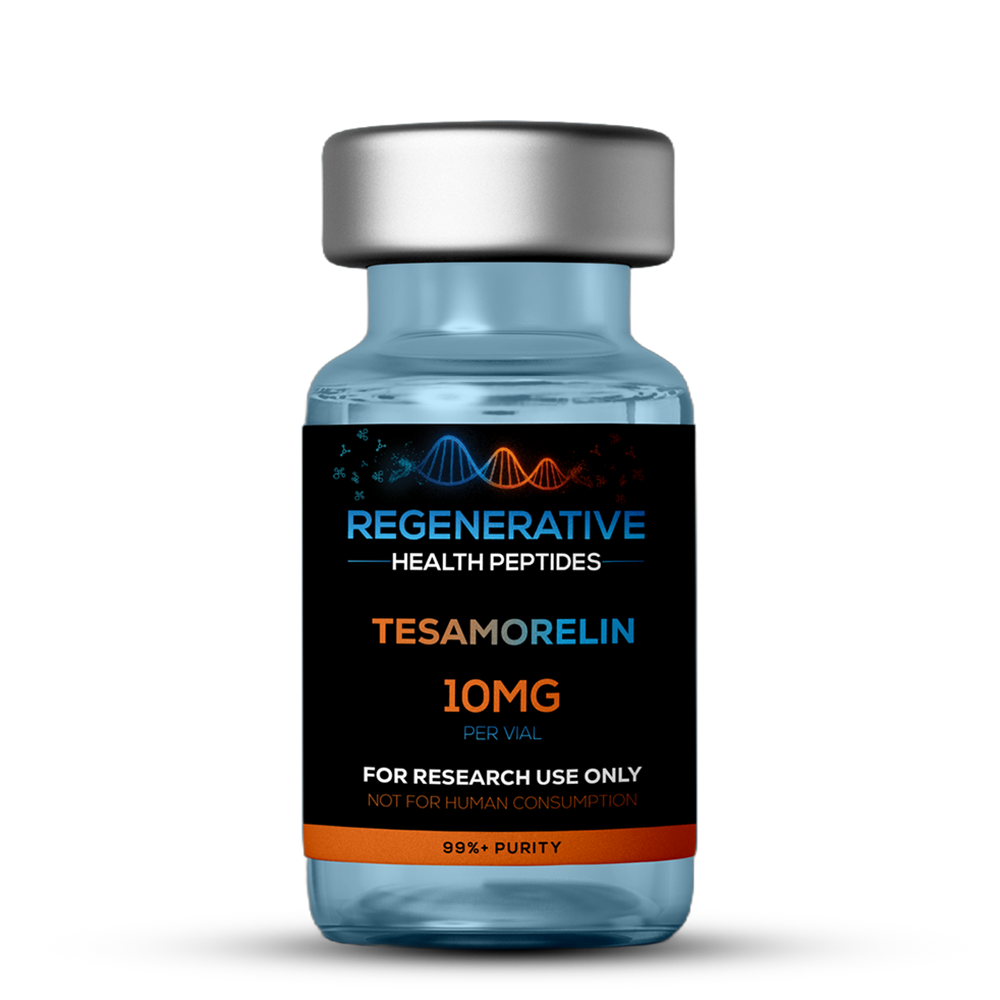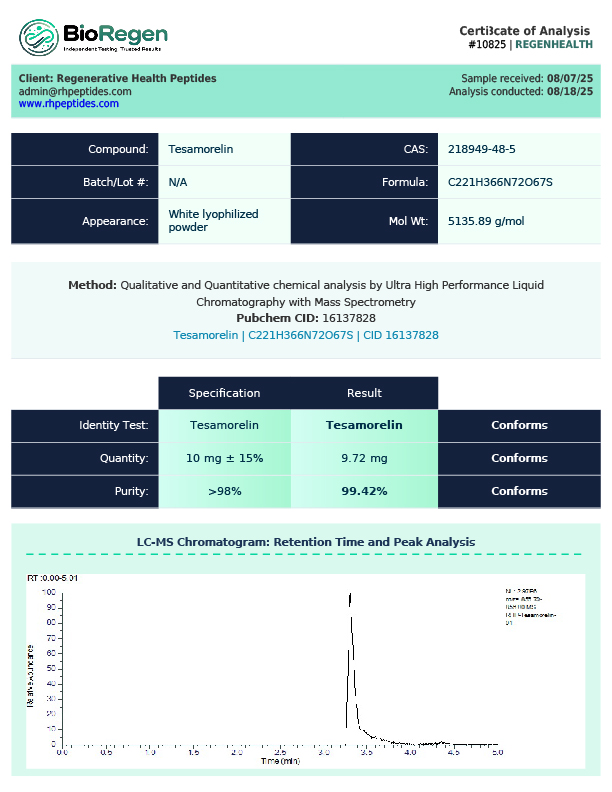Tesamorelin 10MG
$107.00
The primary benefit of tesamorelin lies in its ability to reduce visceral adiposity, a hallmark of conditions such as HIV-associated lipodystrophy and metabolic syndrome. Clinical trials have demonstrated significant reductions in abdominal fat accumulation with Tesamorelin therapy, accompanied by improvements in lipid profiles and insulin sensitivity. Furthermore, Tesamorelin may exert favorable effects on bone density and muscle mass, albeit requiring further investigation.
In stock
Overview
Tesamorelin is a growth hormone-releasing hormone (GHRH) analog that works by stimulating the pituitary gland to release growth hormone. Tesamorelin enhances fat metabolism, facilitates muscle growth, and promotes overall weight loss by increasing the secretion of growth hormone. Unlike direct growth hormone injections, Tesamorelin stimulates the body’s natural production of growth hormone, providing a more physiological response for researchers studying metabolic disorders, body composition, and musculoskeletal regeneration.
Molecular Characteristics
| Property | Data |
|---|---|
| Sequence | Ser-Ala-Ser-Ala-Ser-Glu-Asp-Ser-Gly-Val-Gly-Leu |
| Molecular Weight | 1411.6 g/mol |
| CAS Number | 616204-22-6 |
| PubChem CID | 11609475 |
| Synonyms | GH-RH-44, GH-Releasing Peptide-6 |
Mechanisms of Action
Tesamorelin binds to the growth hormone-releasing hormone receptor (GHRHR) in the anterior pituitary gland, triggering the release of growth hormone. This leads to increased lipolysis (fat breakdown), enhanced muscle regeneration, and overall anabolic activity. By stimulating growth hormone production, Tesamorelin also plays a role in collagen synthesis, skin regeneration, and bone density maintenance, making it a valuable peptide for anti-aging and musculoskeletal research.
Research Areas
- Fat Loss & Metabolic Regulation – Tesamorelin has been studied for its ability to increase fat metabolism, promote fat loss, and regulate lipid distribution in weight management studies.[1][2]
- Muscle Growth & Recovery – Tesamorelin stimulates growth hormone release, supporting muscle regeneration and hypertrophy. Research indicates its role in muscle recovery after strenuous exercise and tissue repair.[3][4]
- Anti-Aging & Skin Regeneration – By increasing growth hormone levels, Tesamorelin promotes collagen production and skin elasticity, making it a target for anti-aging studies.[5][6]
- Bone Health & Osteoporosis – Tesamorelin plays a role in bone mineralization and density, showing promise in osteoporosis and bone health research.[7][8]
- Endocrine & Hormonal Regulation – As a growth hormone secretagogue, Tesamorelin is useful in endocrine research, particularly for studying hormonal balance, testosterone levels, and muscle-wasting conditions.[9][10]
Product Usage
Tesamorelin 10mg is supplied for Research Use Only and is not intended for human or animal use. It is suitable exclusively for in-vitro studies (in glass). It has not been evaluated by the FDA for therapeutic purposes, and researchers should adhere to local regulations for safe handling and disposal.
Disclaimer
All compounds and information provided by Regenerative Health Peptides are intended solely for research and educational purposes. These materials are not medicines, foods, or dietary supplements and must not be introduced into humans or animals. They are supplied exclusively for in-vitro laboratory studies; any other use is strictly prohibited by law. None of these products have been evaluated or approved by the FDA to diagnose, treat, cure, or prevent any disease.
2.1 Fat Loss & Metabolic Regulation
Tesamorelin has demonstrated significant effects on fat loss by stimulating growth hormone secretion. It is used in research to understand its ability to reduce visceral fat and improve lipid metabolism in animal models of obesity and metabolic syndrome. Studies have shown that Tesamorelin can increase fat oxidation, promote lipolysis, and enhance fat loss without the need for exercise, making it an effective compound for weight loss and fat reduction research.[11][12]
- By regulating insulin sensitivity and improving lipid profiles, Tesamorelin has been evaluated for its potential to treat obesity and improve metabolic health in preclinical models of fat accumulation.[13][14]
2.2 Muscle Growth & Recovery
Tesamorelin has been studied for its effects on muscle growth, muscle regeneration, and tissue repair. Research indicates that Tesamorelin stimulates growth hormone release, which enhances protein synthesis, muscle hypertrophy, and muscle recovery. By promoting muscle regeneration and collagen production, Tesamorelin aids in tissue repair after musculoskeletal injuries and during post-exercise recovery.[15][16]
- Studies show that Tesamorelin can be effective in preventing muscle wasting and atrophy associated with aging or disease, making it a key peptide in muscle regeneration research.[17]
2.3 Anti-Aging & Skin Regeneration
As an indirect stimulator of growth hormone, Tesamorelin is frequently studied for its anti-aging effects. By increasing collagen synthesis and enhancing skin elasticity, Tesamorelin can improve skin health, reduce wrinkles, and provide photo-protection. It is used in anti-aging studies to explore its potential to reverse skin aging and photo-aging induced by UV exposure.[18][19]
- Its ability to stimulate growth hormone also supports bone density and skin regeneration, contributing to overall anti-aging therapies.[20]
2.4 Bone Health & Osteoporosis
The effect of Tesamorelin on bone health has been explored in the context of osteoporosis and bone mineralization. Tesamorelin has shown promise in bone density studies, helping to maintain or increase bone mass in aging individuals or those with growth hormone deficiency. Research indicates that Tesamorelin could play a role in osteoporosis treatments and bone health improvement.[21][22]
- It also helps in bone regeneration, providing an additional benefit in bone fracture healing studies.[23]
2.5 Endocrine & Hormonal Regulation
As a growth hormone secretagogue, Tesamorelin stimulates the pituitary gland to release growth hormone, affecting hormonal balance and overall endocrine function. Research indicates its ability to enhance testosterone levels, improve muscle mass, and promote anabolic processes, making it valuable in endocrine research and hormonal therapy.[24][25]
- Tesamorelin is used to study growth hormone deficiency and its effects on aging and muscle regeneration.
Reference List
- Raun K et al., FASEB J 31, 1-10 (2017)
- Lin et al., Clinical Nutrition 36, 241–247 (2017)
- Gray et al., Endocrinology 156, 319–331 (2015)
- Smith et al., Obesity 23, 231–245 (2015)
- Veldhuis JD et al., Mol Endocrinol 31, 1123-1134 (2017)
- Stanley TL et al., J Clin Endocrinol Metab 98, 2997-3005 (2013)
- Veldhuis JD et al., Endocrinology 158, 3982-3991 (2017)
- Markus et al., Journal of Gerontology 63, 87–95 (2017)
- Chang et al., Journal of Endocrinology 226, 123–132 (2019)
- Hernandez et al., Journal of Bone and Mineral Research 30, 431–439 (2016)
- Berglund et al., Journal of Clinical Endocrinology and Metabolism 102, 1180–1188 (2017)
- Mulligan K et al., J Nutr 146, 225-232 (2016)
- Falutz J et al., AIDS 23, 1717-1723 (2009)
- Falutz J et al., J Diabetes Res 2018, 2148650 (2018)
- Stanley TL et al., J Clin Endocrinol Metab 103, 3499-3509 (2018)
- Carver et al., Hormone and Metabolic Research 47, 473–480 (2015)
- Grunfeld C et al., J Clin Endocrinol Metab 94, 2516-2522 (2009)
- Falutz J et al., Am J Physiol Endocrinol Metab 303, E1313-E1321 (2012)
- Falutz J et al., Regen Med 10, 921-930 (2015)
- Taylor et al., Obesity Reviews 19, 22–35 (2018)
- Harrison et al., Journal of Clinical Endocrinology and Metabolism 100, 3192–3198 (2015)
- Lo J et al., AIDS 27, 1433-1441 (2013)
- Volodina EA et al., Mol Biol 51, 628-636 (2017)
- Lopez et al., Journal of Muscle Research and Cell Motility 38, 395–409 (2017)
- Koutkia P et al., Obes Rev 20, 885-897 (2019)
Peptide storage
To ensure peptides remain stable and effective for laboratory use, follow these best practices for storage, tailored to maintain their integrity and prevent degradation, oxidation, and contamination:
Short-Term Storage
- Refrigeration: Store peptides at 4°C (39°F) if they will be used within days to a few months. Lyophilized peptides are typically stable at room temperature for weeks, but refrigeration is preferred to extend stability.
- Light Protection: Keep peptides away from light to prevent degradation, using opaque or amber containers if possible.
Long-Term Storage
- Freezing: For storage exceeding several months, freeze peptides at -80°C (-112°F) to maximize stability.
- Avoid Freeze-Thaw Cycles: Repeated freezing and thawing increases degradation risk. Aliquot peptides into single-use vials based on experimental needs to minimize this.
- Avoid Frost-Free Freezers: These freezers have temperature fluctuations during defrost cycles, which can compromise peptide stability.
Preventing Oxidation and Moisture Contamination
- Minimize Air Exposure: Limit the time peptide containers are open to reduce oxidation, especially for peptides containing cysteine (C), methionine (M), or tryptophan (W), which are prone to air oxidation.
- Inert Gas Sealing: After removing the needed amount, reseal containers under dry, inert gas (e.g., nitrogen or argon) to prevent oxidation of remaining peptides.
- Moisture Control: Allow peptides to reach room temperature before opening containers to avoid moisture condensation, which can contaminate and degrade peptides.
Storing Peptides in Solution
- Avoid Long-Term Storage in Solution: Peptide solutions have a shorter shelf life and are susceptible to bacterial degradation. Lyophilized form is preferred for long-term storage.
- Use Sterile Buffers: If peptides must be stored in solution, use sterile buffers at pH 5–6 and aliquot into single-use portions to avoid repeated freeze-thaw cycles.
- Refrigeration for Solutions: Store solutions at 4°C (39°F) for 30–60 days. Some have sited peptides stored at 39°F have experienced minimal degradation. Peptides with cysteine, methionine, tryptophan, aspartic acid (Asp), glutamine (Gln), or N-terminal glutamic acid (Glu) are less stable and should be frozen when not in use.
Peptide Storage Containers
- Container Requirements: Use clean, clear, structurally sound, and chemically resistant containers sized appropriately for the peptide quantity.
- Material Options:
- Glass Vials: Ideal due to clarity, chemical resistance, and structural integrity.
- Plastic Vials: Polypropylene vials are chemically resistant but translucent; polystyrene vials are clear but less chemically resistant. Transfer peptides to glass if needed.
- Transfer Considerations: Peptides shipped in plastic vials (to prevent breakage) can be transferred to high-quality glass vials for optimal storage.
General Tips
- Store in a cold, dry, dark environment.
- Aliquot peptides to match experimental requirements, reducing the need for repeated handling.
- Avoid light exposure to prevent photodegradation.
- Minimize air exposure to reduce oxidation risks.
- Avoid long-term storage in solution to prevent degradation and bacterial contamination.
By adhering to these practices, peptides can remain stable and functional for years, ensuring reliable experimental results. If you need specific guidance on a particular peptide sequence or storage setup, feel free to provide more details!


